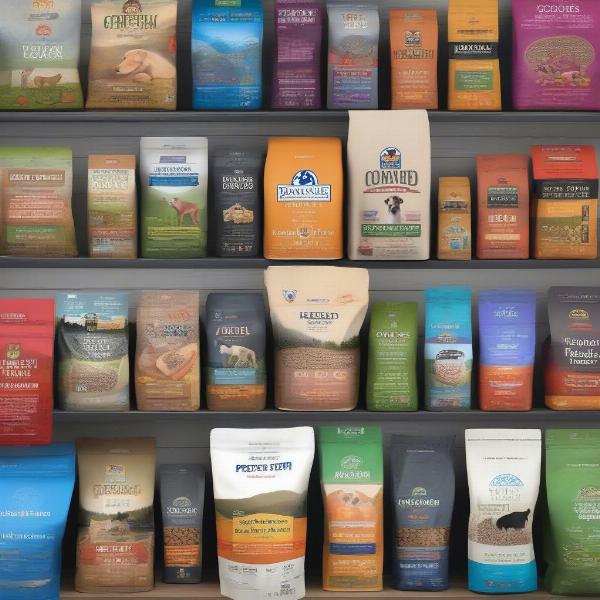Non-GMO dog food is becoming increasingly popular as pet owners prioritize their furry friends’ health and well-being. But what exactly does non-GMO mean, and why should you consider it for your canine companion? This guide explores the benefits of non-GMO dog food, helps you understand what to look for, and provides practical tips for making the switch.
Understanding GMOs and Their Impact on Dog Food
What are GMOs anyway? GMO stands for Genetically Modified Organism. These are plants or animals whose genetic material has been altered in a laboratory. While GMOs in human food are a subject of ongoing debate, their presence in dog food raises similar concerns. Some studies suggest potential links between GMO consumption and health issues in animals, although more research is needed. Choosing non-GMO dog food can be a proactive step in minimizing potential risks and providing your dog with the most natural diet possible.
Benefits of Choosing Non-GMO Dog Food
Opting for non-GMO dog food can offer several advantages for your dog. These include potentially reducing the risk of allergies and digestive issues, promoting a healthier coat and skin, and supporting a stronger immune system. By choosing non-GMO ingredients, you’re providing your dog with food closer to what they would consume in the wild. This can be particularly beneficial for dogs with sensitivities or those prone to health problems.
Reading Dog Food Labels: Identifying Non-GMO Options
Navigating dog food labels can be tricky. Look for certifications like “Non-GMO Project Verified” or “Certified Organic.” These labels indicate that the ingredients have been rigorously tested and meet strict standards for non-GMO sourcing. Pay close attention to the ingredient list. Avoid ingredients derived from common GMO crops like corn, soy, and canola unless they are specifically labeled as non-GMO.
Tips for Transitioning to Non-GMO Dog Food
Switching your dog’s food should be done gradually to avoid digestive upset. Start by mixing a small amount of the new non-GMO food with their current food. Slowly increase the proportion of non-GMO food over several days until they are fully transitioned. Monitor your dog closely for any changes in their stool, appetite, or energy levels during the transition.
Is Non-GMO Dog Food Worth the Extra Cost?
Non-GMO dog food often comes with a higher price tag than conventional brands. However, many pet owners believe the potential health benefits are worth the investment. Consider it a proactive measure towards preventative care, potentially saving on vet bills in the long run.
Common Misconceptions about Non-GMO Dog Food
One common misconception is that all organic dog food is automatically non-GMO. While there’s significant overlap, they are not synonymous. Organic certification focuses on sustainable farming practices, while non-GMO certification specifically addresses genetic modification. Always check for both certifications to be sure.
Where to Find Non-GMO Dog Food
Non-GMO dog food is becoming increasingly available. Check your local pet stores, online retailers, and even some grocery stores. Do your research and read reviews to find brands that align with your values and budget.
 Variety of Non-GMO Dog Food Brands
Variety of Non-GMO Dog Food Brands
Conclusion
Choosing non-GMO dog food is a conscious choice towards prioritizing your dog’s health and well-being. By understanding GMOs and their potential impact, reading labels carefully, and transitioning your dog gradually, you can provide them with a wholesome and nutritious diet. While non-GMO dog food may require a higher investment, the potential long-term health benefits for your furry friend can make it a worthwhile decision.
FAQ
- What does non-GMO mean in dog food? Non-GMO in dog food means the ingredients used haven’t been genetically modified in a lab.
- Is non-GMO dog food better for my dog? While more research is needed, it can minimize potential risks associated with GMOs.
- How do I switch my dog to non-GMO food? Gradually mix the new food with their current food over several days.
- Is organic dog food always non-GMO? Not always. Look for both “organic” and “non-GMO” certifications.
- Where can I buy non-GMO dog food? Pet stores, online retailers, and some grocery stores carry non-GMO options.
- Is non-GMO dog food more expensive? Generally, yes, but it’s an investment in potential long-term health.
- How can I be sure a dog food is truly non-GMO? Look for third-party certifications like “Non-GMO Project Verified.”
open farm dog food ingredients
ILM Dog is a leading international website dedicated to providing expert advice on dog care and nutrition. We offer comprehensive information on everything from breed selection and health care to training, nutrition, and grooming. With our expert insights into the latest pet care trends and best veterinary practices, ILM Dog empowers dog owners worldwide to make informed decisions for their beloved companions. Contact us for personalized advice: Email: [email protected], Phone: +44 20-3965-8624. Visit ILM Dog for more valuable resources.